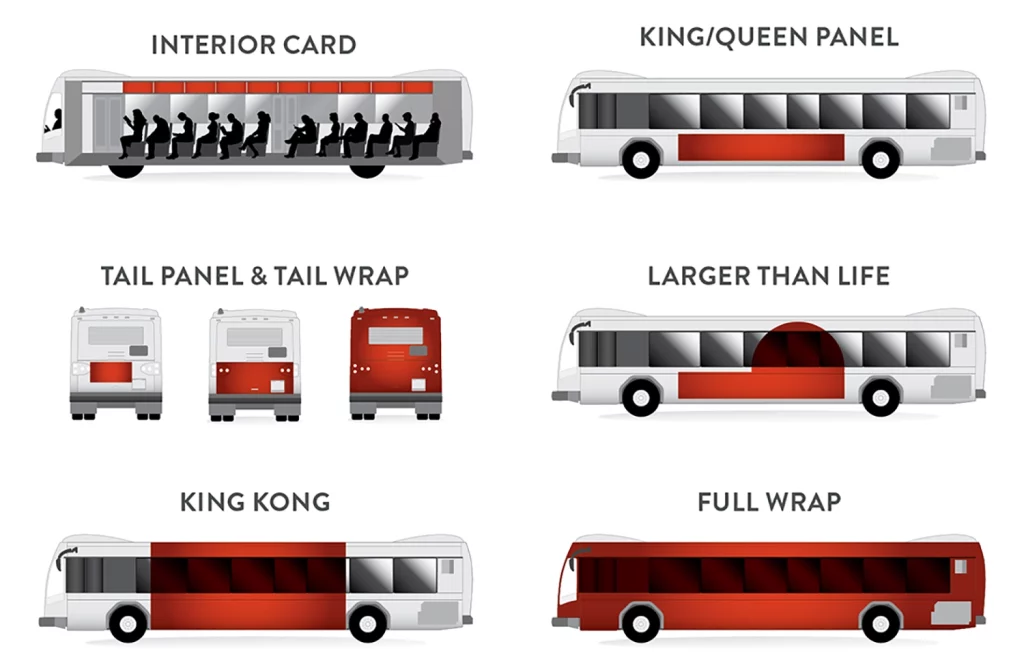Bus Advertising is like Moving Billboards
Bus advertising has been prevalent since the late 19th century. It continues to persist, especially as millions of commuters rely on buses, trains, and even taxis every day, now more than ever.
Bus advertising, in particular, is still an effective approach to promoting brands or products because it is virtually striking, whether for interior or exterior displays.
They also provide maximum exposure to potential customers, from bus drivers to pedestrians, which increases brand exposure and recall. This makes them powerful tools for any marketing campaign.
Cities like London, Sydney, Beijing, Seoul, and Mumbai have seen a significant increase in bus advertising thanks to their effectiveness and extensive bus networks.
Key Benefits of Bus Advertising
If it was not clear, bus advertising is very effective and has the following benefits in comparison to other marketing strategies.
Enhanced Visibility: Bus ads are large and easily noticeable, reaching a broad audience. Netflix used them effectively with QR codes for direct engagement.
Broad Reach: Buses travel through various areas, ensuring exposure to diverse audiences. Repetitive routes reinforce brand messaging.
Targeted Audience: Bus ads can be strategically placed to reach specific demographics, increasing campaign effectiveness.
Cost Efficiency: Bus advertising is cost-effective, with lower ongoing costs and a longer ad lifespan compared to other outdoor options.
The 4-Step Bus Advertising Process
Now that the benefits of bus advertising are clear let’s walk through the essential steps to turn your idea into a high-impact campaign. From crafting your design to choosing strategic routes, each stage holds the key to maximising visibility and engagement. Dive in to discover the four steps that will bring your ad from concept to a moving billboard.
Step 1: Choose the bus advertising format
The choice of ad format depends on your budget and preferred ad design. Once you define these factors, you will have the following advertising options:
- Full wrap — These full-body wraps create a comprehensive brand experience, covering all sides of the bus. They are highly impactful but can be costly.
- King Kong format — This format covers the entire side of a bus, providing maximum visibility and brand dominance, which is ideal for large-scale campaigns.
- Side panel format (Larger Than Life or King/Queen Panel)—The side panel, usually the height of the bus and a window panel wide, is suitable for reaching commuters and pedestrians. It allows for a clear and memorable brand message.
- Tail Wrap—This format covers the entire back of the bus, delivers a strong brand presence, and can be highly effective for increasing awareness.
- Tail Panel — Slightly smaller than the full-back format, usually comes in two options.
- Interior card (internal formats)— Placed inside the bus, these ads offer more prolonged exposure to commuters.
Step 2: Calculate your bus advertising budget
To calculate your bus advertising budget, you will need to consider factors like the ad size, placement, route, and duration.
- Ad Size and format — The cost increases with larger ad formats like Full Wraps, Full Back, or Megaside buses. Full Wraps, which cover the entire bus, offer the highest visibility but also come at a higher cost. A Full Wrap bus can cost approximately $25,520 for an eight-week campaign for a discounted media rate, plus installation and production costs.
- Route — Bus ads travelling in highly populated urban areas or along major routes command higher prices compared to suburban or less trafficked areas due to increased exposure.
- Duration — For bus advertising, a minimum of 8 weeks is recommended to allow for repeated exposure to target audiences and ensure prolonged engagement.
Budget Calculation Example (actual figures):
- Ad Format — Full Back Bus ($2,900 per month)
- Production Cost — $1,057
- Installation Cost — $275
- Total for 8 weeks — Approximately $7,132 per bus.
For multiple buses or an extended campaign (e.g., 12 weeks), multiply the media rate and installation costs, keeping in mind that discounts typically apply for bulk orders.
Step 3: Design your bus ad
A visually appealing and impactful ad design is crucial for the success of a bus advertising campaign. A well-designed ad will capture the attention of commuters, communicate the message effectively, and drive action.
Here are some tips for designing a successful bus ad:
- Convey clear messaging. Keep your message simple and easy to understand. Use clear language and avoid jargon. Also ensure your ad text is large enough and easy to read from a distance.
- Emphasise call to action. Encourage viewers to take a specific action, such as visiting your website, calling a number, or downloading an app.
- Include contact information. Clearly display your contact information in an appropriate part of your ad design, including your website, phone number, and email address.
Also consider that bus advertising has its own limitations and best practices, some of which include the following:
- Size Restrictions. Bus ads have specific size limitations depending on the type of bus you choose. Ensure your design adheres to these restrictions to avoid rejection.
- Cultural Sensitivity. Australia is a culturally diverse country. When designing your ad, be mindful of cultural sensitivities and avoid offensive or inappropriate imagery.
Bus Ad Design and Product Limitations in Australia
While there may be some regional variations, the design and product limitations for bus ads in Australia are generally consistent.
The Australian Advertising Standards Bureau (AASB) sets standards for advertising in Australia. Their website provides more information.
Step 4: Finalise your contract
Before diving into the key elements of a bus advertising contract, it’s important to note that the specific terms and conditions may vary depending on the company and your location within Australia.
Numerous companies offer bus advertising services, so it’s advisable to research and compare options to find the best fit for your needs.
A bus advertising contract should specify the advertising space, detailing the exact bus locations for ad displays, such as the exterior (sides, front, or back) or interior areas. Next, identify the duration of the campaign, which may be a fixed period (e.g., one, three, or six months) or flexible for events or unique campaigns.
Payment terms should include the schedule and method, often involving upfront or combined upfront and recurring payments. Finally, incorporate additional agreements that cover essential aspects like creative approvals, reporting, maintenance, repairs, and any cancellation policies.
It’s highly recommended to consult with a reputable marketing company for professional guidance when finalising your bus advertising contract. They can provide valuable insights, negotiate on your behalf, and ensure that your contract aligns with your campaign goals and budget.
Bus Advertising Cost Table
Below is a reference cost table from one of our partners. Please note that the actual costs of bus advertising may vary. It is recommended that you contact multiple companies and request quotes to better understand the costs involved in your specific bus advertising campaign.
Bus Ads That Gained Attention
The goal of creative advertising is to make a lasting impression on consumers, generate buzz, and ultimately drive brand awareness and sales. By thinking outside the box, creative ads can help brands differentiate themselves from competitors and build a stronger connection with their target audience.
Here are some examples of creative ads that generated buzz during their campaign run:
Copenhagen Zoo, Copenhagen, Denmark
The Copenhagen Zoo’s innovative bus ad campaign, featuring giant boa constrictors “squeezing” city buses, was a masterstroke in creative marketing. By leveraging the unique capabilities of graphic printing and collaborating with city transit authorities, the zoo was able to create a highly memorable and impactful advertising campaign.
The bus ad made use of great visual impact. The giant boa constrictor wraps on city buses created a striking and attention-grabbing visual that was noticed by a wide audience, even those not actively seeking information. It also showed relevance and engagement by directly tying into the new reptile exhibit, making it immediately relevant to potential visitors.
The campaign’s payoff was significant: attendance surpassed projections by 30%, demonstrating the effectiveness of the creative approach and the ability of bus advertising to drive patronage.
Specsavers, Queenstown, New Zealand
Specsavers’ “Bus Back Crash” campaign showed how creative and targeted out-of-home advertising can be highly effective.
The dramatic image of a bus seemingly crashing into a parking sign immediately grabs attention. The visual impact aligns with the campaign’s message of avoiding accidents due to poor eyesight.
While the ad’s meaning might not be immediately apparent to everyone, it certainly sparks curiosity and encourages viewers to investigate further. This can lead to increased online traffic and engagement with the Specsavers brand.
It also highlights the ability of bus advertising to be precisely targeted to specific geographic areas, allowing businesses to tailor their messaging to local audiences and increase their relevance.
Duracell Batteries, New Delhi, India
Duracell’s innovative bus ad campaign, featuring a bus seemingly powered by Duracell batteries, was a clever and attention-grabbing marketing stunt. The ad cleverly played on the stereotype of batteries being small and insignificant, while simultaneously highlighting the brand’s power and reliability.
The contrast between the size of the bus and the battery creates a humorous and memorable effect.
The ad effectively conveys Duracell’s message of power and reliability. By suggesting that their batteries can power a bus, the campaign implies that Duracell batteries can handle even the most demanding tasks.
While the ad is clearly exaggerated, it remains relevant to Duracell’s target audience by associating the brand with power and reliability, positioning Duracell as a premium battery brand.
International Organisation for Migration, Kenya
Bus advertising campaigns are not limited to products and corporate campaigns.
The “Stop Human Trafficking!” bus advertising campaign by the International Organisation for Migration (Kenya) was launched with the goal of raising public awareness about human trafficking.
The design included a powerful image of a child in the dark luggage compartment, symbolised the hidden nature of human trafficking. The use of direct language like “Stop Human Trafficking!” immediately conveyed the severity of the issue.
The “Stop Human Trafficking!” bus ad campaign serves as a strong example of how outdoor advertising can be utilised to address critical social issues. By combining high visibility, direct messaging, and emotional appeal, the campaign helped raise awareness and drive action.
































































